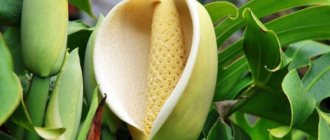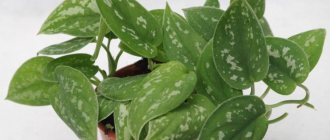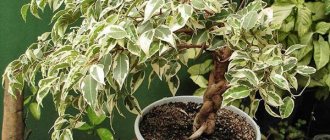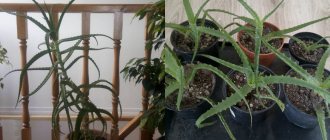How to prune monstera
A mandatory care item for Monstera is pruning. The growth of the plant should be controlled to give it a neat shape and the required size. It is also necessary to pay attention to aerial roots.
Crown formation
Monstera easily tolerates pruning, and the cut off parts can be used as cuttings. This allows you to not only successfully propagate this flower at home, but also give it the desired shape.
The flower can be grown as a vine or maintained as a bush. The cutting technology depends on this.
Can be formed in the form of a vine or bush
Liana
As a rule, shaping is necessary for climbing specimens. It is performed step by step and involves several actions:
- Shortening shoots that are too long.
- Removing old unattractive leaves.
- Pruning shoots to stimulate branching.
Important! To make the flower look more decorative, it is better to plant 2 or 3 cuttings in one pot. Three powerful lashes with spreading leaves look very impressive. When forming several trunks, each of them requires separate support.
Bush form
Very often in flower shops you can see compact monsteras that look like a spreading bushy plant. Such specimens are usually more expensive, but this does not mean that amateur gardeners cannot create a plant of this shape on their own.
There are two ways that allow you to grow a monstera in the form of a bush:
- If an adult plant is used on a support, it is shortened as much as possible, and some of the cuttings are planted in the same pot.
- You can give the monstera this shape when planting cuttings. To do this, short tops with 1-2 aerial roots are planted in one pot.
Liana propagation
There are several ways to propagate vines. Perhaps the best and most common method is propagation by stem cuttings. Step-by-step instruction:
- Cut the shoots so that at least one bud and one leaf remain on each of them.
- Dry the cut areas and sprinkle with charcoal powder. After this, 2-3 cuttings are planted in one pot, and the soil should contain perlite.
- The soil should not dry out, and the temperature in the house should be above 20°C. To make the cuttings take root faster, you need to cover them with a jar or bag. Sometimes this is a very long process that can take up to six months.
Propagation by air layering is not the easiest method to use at home, but it is more effective than others. One of its advantages is that nothing needs to be cut off from the monstera. You should find the shoot with the strongest and healthiest aerial roots on the plant and create moist conditions. To do this, you can wrap it with moss (attached with polyethylene), which must be constantly sprayed and watered.
Flower propagation
Propagation by apical cuttings involves cutting off the top of an adult monstera and placing the resulting cutting in a container of water. It is already possible to replant when three root shoots are formed on it.
Note! Variegata monstera has poisonous juices that are harmful to human skin. When working with them for a long time, there is a risk of getting burned. Therefore, you should always wear gloves.
In addition to the above methods, the flower can also be propagated by leaves and lateral shoots, but these methods are not so convenient and effective.
Thus, the variegated monstera is an excellent option for an apartment: it complements the interior and does not require special costs or maintenance. To keep it at home, you only need to observe the optimal conditions that were described in this article. The flower will reward you with an unusual and pleasing appearance and clean air in the house.
What kind of pot should a monstera have?
Monstera is a large flower. He needs a fairly large pot (30cm in diameter). The bottom of the pot definitely needs drainage. The soil consists of equal parts of compost soil, sand and peat.
Interesting materials:
How to transplant a rose from one place to another? How to replant an adult pear tree? How to forward an audio message on Instagram? How to stop getting mad at everything? How to forward all letters from one mail to another? How to reinstall Odnoklassniki? How to reinstall WhatsApp on Android? How to flip a matrix in Matkada? How to convert UEFI to Legacy? How to reboot 70mai?
What do aroids need?
If they almost always have enough light and the temperature suits them, then the air humidity, alas, is much lower than in natural habitats. In their homeland, philodendron, monstera and epipremnum vines develop adventitious roots with each new leaf that appears. This allows them to be immediately fixed to the support and increase the feeding area. Each subsequent leaf becomes larger and more dissected, and finally the plant is ready to bloom. But in a standard office or residential space, the opposite is true: the leaves become smaller, the stems become elongated, and the plant loses its appearance.
Dieffenbachia and aglaonema, although not vines, also grow adventitious roots from nodes when air humidity increases. These plants are heavy, and once they grow to a certain size, they cannot remain upright. When the top lies on the ground, when the stem comes into contact with a damp surface, new roots quickly grow, with the help of which the plant can again grow vertically upward.
Now let’s think about what we like better: growing large aroids on a support or using the rapid formation of roots in a different way?
Believe me, it takes a lot of time to moisturize the support several times a day, but it is not very effective. I have always kept my aroids in a show “body” in a different way, which allows me to constantly maintain decorativeness and at the same time not raise domestic “monsters” that bother everyone.
philodendron
If you cut off the top of a monstera. Is it possible to remove aerial roots from Monstera?
If you have monstera, aerial roots or tendrils, this plant makes you wonder what they are for and what to do with them.
The presence and good condition of the mustache indicates the health of the monstera and its vitality, but they do not look aesthetically pleasing, and their purpose is not entirely clear. Is it possible to remove aerial roots from Monstera? Read on. Flower growers do not recommend doing this - you can weaken the plant, which, with the help of these air layering, extracts additional moisture from the air. Many people send them to the same pot in which the vine grows, then as the roots become lignified, the monstera acquires strong natural support, and the airy tendrils extract nutrients from the soil.
Other gardeners place vases with water or soil next to the monstera and lower the cuttings into them, wrap the airy tendrils in wet moss, in this case their function is breathing and extracting moisture.
You can make a support for the monstera, which will simultaneously feed the aerial roots - take a plastic pipe with a diameter of 10 cm and drill holes into which the aerial layers can freely fit. The surface of the pipe can be wrapped in coconut fiber.
Bury the bottom end of the pipe in the pot and fill the bottom with stones for stability, and fill the rest with moist sphagnum. The mustache will penetrate inside the pipe, and it will serve as both a support and an additional source of moisture for the monstera.
Not all of its owners know how to prune a monstera correctly - this should be done carefully, trying not to damage the aerial roots, and if you need side shoots for propagation, cut them as much as necessary, and if not, just remove the wilted leaves of the monstera. It does not need radical pruning.
What is a variegated monstera
The term "variegata" appears in the names of many plants. Their distinguishing feature is their variegation. This effect was achieved through certain mutations at the gene level. To understand how to properly care for such a plant and how variegated forms differ from others, you need to understand what variegation means.
Monstera deliciosa - poisonous plant or not
The presence of white, pink or milky shades in the color of plants is due to the partial presence of chlorophyll-free cells in the genetic composition. They are the result of a mutation. Several genotypes are present in the cell tissues of such plants.
Attention! The nutrition and growth of variegated species is carried out only due to the presence of green parts of the plant. If white color dominates, the flower is not viable.
There are several varieties of monstera with variegated leaves. The most common is Alba - this is the flower that can most often be found in flower shops.
Monstera species
Up to 30 species grow under natural conditions; only a couple of varieties are suitable for growing indoors:
- Monstera delicacy. The most common type that is found in almost everyone who grows monstera. Tall plant with huge leaves.
- Monstera is unequal or oblique. A miniature, graceful plant with oblong-shaped leaves. It got its name due to the lack of symmetry. The leaves are up to 20 cm long and only 6 cm wide.
- Monstera Variegata. Variegated form. A characteristic feature is its small size and beautiful green-gray foliage with swirls and white inclusions.
- Monstera Adanson. You can find variegated and green forms. Yellow stripes are beautifully scattered across the ovoid foliage.
Variegata
Uneven-sided
Delicatessen
Adanson
Caring for Monstera aerial roots
The aerial roots of Monstera are an inseparable and important part of the variegata; they cannot be cut off if they do not interfere in any way. If you nevertheless decide to remove them, then you need to reduce the length of the aerial roots by about half; they will temporarily stop growing.
The roots located lowest on the trunk should be directed into the soil if they reach it. This can be done by carefully tying them to the trunk of the plant. Some roots located higher up may even attach themselves to the wall.
Note! You can pour the settled water into several containers and place the roots there.
In general, by their nature, aerial roots are intended not so much for nutrition as for support. They, like all monsteras, need to be sprayed (this needs to be done about once a week), otherwise they will be the first to suffer if there is a lack of moisture.











